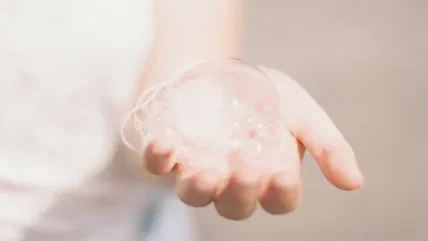
First steps
Improving performance starts at the counter where it is vital that staff are aware of the following stain types that frequently cause problems.These stain types can be far easier to deal with and the chances of success are much improved if they are pre-spotted.
Water-based
- Blood, egg
- Larger areas of water based stains like tea, red wine, colour and beer
- Pollen
Oil-based
- Leaked ballpoint ink
- Marks from polystyrene type plastics
Most cleaners pre-spot a much wider range of stains, however, the list is representative of the stain types that frequently cause problems, operators should be alert to these stain types and particularly aware of the risks of heat setting.
Water-based staining
Blood, egg and any other stains that contain albumen, ie, milk can be heat set in drycleaning. This process starts during the dry cycle and if subjected to the heat in finishing, they may be impossible to remove. Albumen is soluble in water and, unless they are heated, albumenous stains are normally easy to remove with blood spotting reagents but once subjected to the heat of ironing or pressing albumen is no longer water soluble. Prolonged treatments with blood spotter followed by an enzyme reagent and as a last resort bleaching with 9% hydrogen peroxide offer the best chance of success.
While small stains like red wine, blood, tea, coffee and beer can all be pre-spotted locally with kit spotters – subject to fabric/ fibre type; larger stained areas need to be assessed at the counter for washing or wetcleaning. Once again, due to the sugar content of some water-based stains, any residual sugar may be heat set during drying and finishing leaving stubborn, difficult to remove brownish marks.
Pollen
Pollen can be very difficult to remove but the chances are much improved if a strong vacuum is used to remove loose particles. Spot the remaining pollen with a kit tannin remover and flush out with the cold water spray, then apply bar soap and flush out with the steam gun. Subject to fabric/ fibre type any remaining stain can be bleached using 9% hydrogen peroxide.
Oil based stains
Leaked ballpoint pen ink (see also WWW, LCN December 2021). This is one of the most difficult and challenging stains. Remove the heavily contaminated pocket lining and unpick the jacket lining to allow access to the ink inside. Place absorbent fabric under the stain and apply a ring of glycerine around it to prevent spreading. Apply paint remover and pad out the stain from the top with absorbent fabric with frequent changes underneath. Finally, flush out with bar soap or blood spotter and the steam gun, then bleach with 9% peroxide. Use old stock items to practice the procedure.
Plastic stains
Plastic stains normally arise from designer swing tags, plastic beads or buttons which partially dissolve in perc. and may stain other items in the load, once again stains can be difficult to remove. Plastic stains should be spotted with paint remover; two or more paint spotters help with the removal of various types of plastic. Follow with a kit dye/colour spotter and finally bleach with 9% hydrogen peroxide. Testing with solvent before cleaning is the answer.






